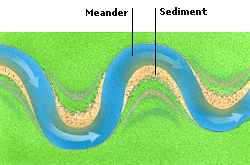DK Science: Lakes
Lakes form where water fills hollows in the landscape. Some of these hollows are formed by glaciers gouging into the ground, and some are created when river valleys are blocked by dams. Other lakes are formed in volcanic craters, or when land sinks during earth movements. Most lakes contain freshwater, but there are some saltwater lakes, such as the Dead Sea between Israel and Jordan.

Rivers can gradually produce lakes as they flow. The outside banks of the meanders (bends) erode and sediment builds up on the insides, making the meanders longer.

Eventually two ends of a meander get so close to each other that the water breaks through. This often happens during a flood. Now most river water by-passes the bend.

The water flowing into the bend slows down. It drops its sediment, which blocks the ends of the bend, leaving a crescent-shaped lake called an ox-bow lake.

These lakes on the Isle of Skye in Scotland were created by glaciers thousands of years ago. Glaciers begin to form high on mountain sides, from snow and ice which builds up and scours hollows in the rock called cirques. When the glaciers melt, these fill with melt water to form cirque lakes, which continue to be fed by rainwater flowing off the hillsides.
